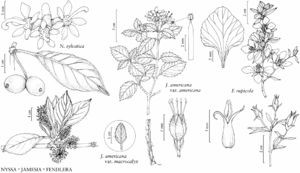Jamesia
Fl. N. Amer. 1: 593. 1840.
| Taxon | Illustrator ⠉ | |
|---|---|---|
 | Nyssa sylvatica Fendlera rupicola Jamesia americana var. macrocalyx Jamesia americana var. americana | Yevonn Wilson-Ramsey Yevonn Wilson-Ramsey Yevonn Wilson-Ramsey Yevonn Wilson-Ramsey |
Shrubs. Stems ascending or spreading. Bark exfoliating in sheets, strips, or strings. Branches ascending, spreading, or descending; twigs with simple trichomes. Leaves deciduous, opposite; petiole present; blade ovate or broadly ovate to obovate, rhombic, or suborbiculate, herbaceous, margins usually crenate to dentate, rarely entire, plane; venation pinnate. Inflorescences terminal, cymes, 2–35-flowered, sometimes flowers solitary; peduncle absent or present. Pedicels present. Flowers bisexual; perianth and androecium perigynous; hypanthium completely adnate to ovary, hemispheric, not ribbed in fruit; sepals persistent, 4–5, erect, lanceolate to narrowly ovate, sparsely to densely strigose, canescent, or sericeous; petals 4–5, imbricate, spreading, white or pink, obovate or oblanceolate, base clawed, sometimes obscurely, surfaces hairy; stamens 8 or 10; filaments distinct, dorsiventrally flattened, gradually or abruptly tapered from base to narrow apex, apex not 2-lobed; anthers depressed-ovate; pistil 3–5-carpellate, ovary to 1/2 inferior, partially 3–5-locular initially, becoming 1-locular; placentation axile proximally, parietal distally; styles persistent, (2–) 3–5, distinct. Capsules ovoid or conic, indurate, dehiscence basipetally septicidal to middle of fruit. Seeds 25–50 per locule, orangish brown or tan, ellipsoid. x = 16.
Distribution
United States, n Mexico
Discussion
Species 2 (2 in the flora).
This treatment of Jamesia is essentially an adaptation of that by N. H. Holmgren and P. K. Holmgren (1989).
Fossil leaves referred to Jamesia have been identified in Oligocene sediments from Colorado and Montana; the identity of material from the latter site is ambiguous (N. H. Holmgren and P. K. Holmgren 1989).
In the key and descriptions that follow, tooth number is per leaf.
Selected References
Lower Taxa
Key
| 1 | Sepals 5; petals 5; stamens 10; inflorescences usually 3–35-flowered, cymose, rarely 1–2-flowered on lateral branches; leaf blade margins (5–)9–51(–69)-toothed. | Jamesia americana |
| 1 | Sepals 4; petals 4; stamens 8; inflorescences (1–)3-flowered; leaf blade margins usually 3–13(–16)-toothed, rarely entire. | Jamesia tetrapetala |
"connate" is not a number. "distinct" is not a number.